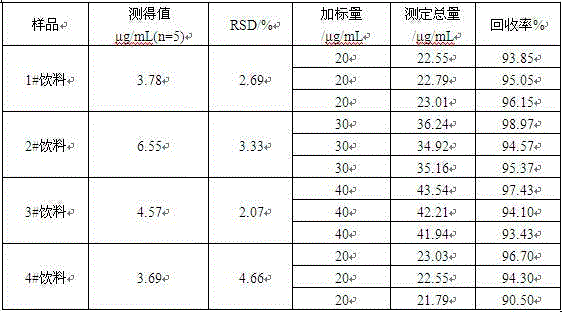Method for detecting content of lemon yellow in beverage sample
A lemon yellow and beverage technology, applied in material excitation analysis, fluorescence/phosphorescence, etc., can solve problems such as human health damage, and achieve good precision and accuracy.
- Summary
- Abstract
- Description
- Claims
- Application Information
AI Technical Summary
Problems solved by technology
Method used
Image
Examples
Embodiment
[0018] (1) Accurately weigh 0.0122g of isatin-p-phenylenediamine bis-Schiff's base, dissolve it in 10mL of N,N-dimethylformamide (DMF) solvent, dilute with ultrapure water, and prepare a solution of 122ng / mL.
[0019] (2) Accurately weigh 0.0532g of nano-graphene oxide (rGO) dissolved in 5mL of ultra-pure water and dilute it in a 10mL volumetric flask to obtain a stock suspension of nano-graphene oxide with a concentration of 5.32mg / mL, and place it in a cool place Save it for later use, and dilute it into solutions of different concentrations when used.
[0020] (3) Dilute the nano-graphene oxide stock suspension with a concentration of 5.32 mg / mL obtained in step (2) to prepare a nano-graphene oxide suspension with a concentration of 2.66 μg / mL.
[0021] (4) Add 2 mL of the solution obtained in step (1) and 2 mL of the nano-graphene oxide suspension with a concentration of 2.66 μg / mL obtained in step (3) into a 10 mL stoppered test tube, and shake well to obtain a mixed solu...
PUM
 Login to View More
Login to View More Abstract
Description
Claims
Application Information
 Login to View More
Login to View More - R&D
- Intellectual Property
- Life Sciences
- Materials
- Tech Scout
- Unparalleled Data Quality
- Higher Quality Content
- 60% Fewer Hallucinations
Browse by: Latest US Patents, China's latest patents, Technical Efficacy Thesaurus, Application Domain, Technology Topic, Popular Technical Reports.
© 2025 PatSnap. All rights reserved.Legal|Privacy policy|Modern Slavery Act Transparency Statement|Sitemap|About US| Contact US: help@patsnap.com


